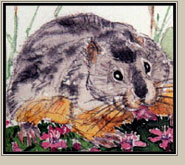 |
WILDLIFE: Lemmings
 For
centuries, Norwegians have puzzled over why the population of hamster-like
lemmings rises dramatically some years and crashes in others. So
great is the fascination with these rodents of the far north that
ancient Norwegian sagas, or legends, refer to them. In the popular
imagination outside of Norway, lemmings are the strange animal the
occasionally commits suicide in massive numbers by leaping off cliffs.
This conception, it turns out, is a fantasy with no basis in fact,
disseminated in largely by the 1958 Walt Disney "documentary," White
Wilderness. (Reportedly, filmmakers paid Inuit hunters a bounty
to collect lemmings then hurled the animals off the cliffs themselves.) For
centuries, Norwegians have puzzled over why the population of hamster-like
lemmings rises dramatically some years and crashes in others. So
great is the fascination with these rodents of the far north that
ancient Norwegian sagas, or legends, refer to them. In the popular
imagination outside of Norway, lemmings are the strange animal the
occasionally commits suicide in massive numbers by leaping off cliffs.
This conception, it turns out, is a fantasy with no basis in fact,
disseminated in largely by the 1958 Walt Disney "documentary," White
Wilderness. (Reportedly, filmmakers paid Inuit hunters a bounty
to collect lemmings then hurled the animals off the cliffs themselves.)
For decades scientists have also taken note of the strange behavior
of lemmings. Researchers have shown that these animals, which only
live in Arctic regions, go through cycles that are about four years
long. Although figures vary depending upon region, the population
of lemmings can easily multiply by a factor of two or three hundred
over a period of just two years, before dropping down again. Scientists
have learned how this is possible. Lemmings can have several litters
in a year. Moreover, the virile animals become sexually mature only
a month after birth.
However, these scientists still wonder why the numbers go up and
down the way they do. There have many theories. One idea, which
is now discredited even by its own author, is that lemmings die
of stress when their numbers become too great. The cycle of sunspots
has also been suggested as a possible explanation, though today
scientists generally regard this idea as implausible. The two most
likely explanations are that lemming cycles are controlled by the
availability of food or by the activity of predators.
For the last 16 years, French biologist Benoit Sittler, who teaches
at the University of Frieberg in Germany, has been studying Greenland's
collared lemming on Traill Island in East Greenland. For about two
months each summer, Sittler and a crew of graduate students and
assistants scour about five square miles of prime lemming habitat
for evidence of winter nesting. They also set traps alongside summer
burrows to gauge the summer population.
Sittler and Olivier Gilg, who just completed a Ph.D. dissertation
on lemmings at the University of Franche-Comté in France, have concluded
that, at least on Traill Island, it is the interaction between the
lemmings and their primary predator, the ermine, that controls the
population of the small rodents. The two researchers have shown
that the peaks and valleys of the ermine population always follow
those of the lemming population by a year.
This year there were virtually no lemmings on Traill Island, an
unexpected finding since it has been four years since the lemming
population last peaked, and since the time between peaks and valleys
is usually only two years. Arctic foxes, which eat lemmings during
the summer, have had to find other food because the lemmings were
absent. So the numbers of Arctic hare, eider ducks and geese--all
alternate food for the foxes--were also low. Snowy owls, which frequent
Traill Island when lemming numbers are high, were absent.
 |
 |

 |
 |

 |
 |
Lemmings
See photos of the scatological remains lemmings
in Greenland. |
 |
|
 |
|
 |
 |
Vikings | Inuit
| Wildlife
| Ice Cores
| Dispatches
| Teacher
Guides | Credits
© Copyright 2003, WBUR
|
 |











